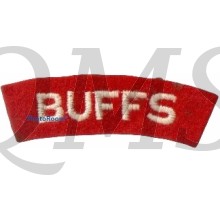Shoulder flash York and Lancaster Regiment
Second World War
During the Second World War, the regiment raised ten battalions, six of which served in the Burma Campaign in various roles. Other units of the regiment saw service in Europe – both the 1st Battalion and The Hallamshire Battalion were involved in the Norwegian campaign.
- 1st Battalion – 5th Infantry Division
- 2nd Battalion – 70th Infantry Division later converted to Chindits
- 3rd Battalion – Depot
- The Hallamshire Battalion – 146th Brigade, 49th (West Riding) Infantry Division
- 5th Battalion – 67th (York & Lancaster) Heavy Anti-Aircraft Regt. Royal Artillery, TA
- 6th Battalion – served with the 46th (West Riding) Infantry Division
- 7th Battalion – infantry (based on North West Frontier for most of the war).
- 8th Battalion – infantry (25th Indian Infantry Division)
- 9th Battalion – infantry (25th Indian Infantry Division)
- 10th Battalion – In 1941 was converted to armour as 150th Regiment Royal Armoured Corps, but continued to wear their York & Lancaster cap badge on the black beret of the RAC. The regiment served in the 254th Indian Tank Brigade.
The 1st Battalion was carried to and from Norway by HMS Sheffield; this led to a bond of friendship between the regiment and the ship, and meant that when the Sheffield was adopted by its namesake city, the Yorks and Lancs was awarded the freedom of Sheffield soon after. This battalion served in the 15th Infantry Brigade, part of the 5th Infantry Division and after being shipped around most of the British Empire was finally sent to Italy where they fought through that campaign from 1943 to 1945.
The 2nd Battalion (part of the 14th Infantry Brigade), before becoming Chindits, was involved in the defence of Heraklion, during the Battle of Crete in 1941.] Most of their casualties in this battle were suffered in the withdrawal by the Royal Navy which came under heavy air attack from the German Luftwaffe. On returning to Egypt they became part of the British 70th Infantry Division used in the breakout from Tobruk, where they suffered heavy casualties as one of the lead battalions. They were transferred, along with the rest of the 70th Infantry Division, to India and Burma where they took part in the 2nd Chindit Campaign and the Arakan offensive toward the end of the war.
The Hallamshire Battalion, were part of Mauriceforce (Norwegian Campaign) in Norway in April 1940. The Hallamshires took part in the unsuccessful Namsos Campaign and were evacuated back to Britain by 5 May. The Hallamshires did not see active service until it was landed in Normandy soon after D-Day and fought its way through France, Belgium (where Cpl.J.W.Harper won the regiment's fifth Victoria Cross), and into the Netherlands where they were part of the bitter fighting that led to the eventual capture of Arnhem in 1945.
The former 5th Battalion (Territorial Army), which had converted to anti-aircraft artillery in 1936, as the 67th (Y & L) HAA Regiment, Royal Artillery, served in the North African Campaign in 1941 before being transferred to India and then Burma where they were prominent at Imphal, and later at Mandalay. From October 1944 to January 1945 the regiment served as infantry due to the shortage of manpower
The 6th Battalion went to France in 1940 with the 46th Infantry Division, and experienced heavy fighting in the St. Omer — La Bassee area. In 1942 the Division was part of the First Army in Tunisia, and from 1943 until the end of the war they fought with the Eighth Army in Italy, from Salerno to Rimini.
Meanwhile the 7th Battalion was in India (from December 1942), but served mainly on the North-West Frontier, before being moved to Burma in 1945, too late to contribute to the defeat of Japan.
The 8th and 9th Battalions, after being stationed in Northern Ireland from 1940 to 1942, were both sent to India in 1942 where they joined the Indian 25th Infantry Division. The two battalions took a significant part in the Arakan battles of 1942–1943 and in the battles for southern Burma in 1944 to 1945.
The 10th Battalion was converted to tanks in India, becoming the 150th Regiment, Royal Armoured Corps, in the 254th Indian Tank Brigade. The 150th Regiment used Lee tanks with which it fought at the Battles of Imphal, Kohima and Meiktila and on the advance to Rangoon (Operation Dracula).
The York and Lancaster Regiment was an infantry regiment of the British Army.


